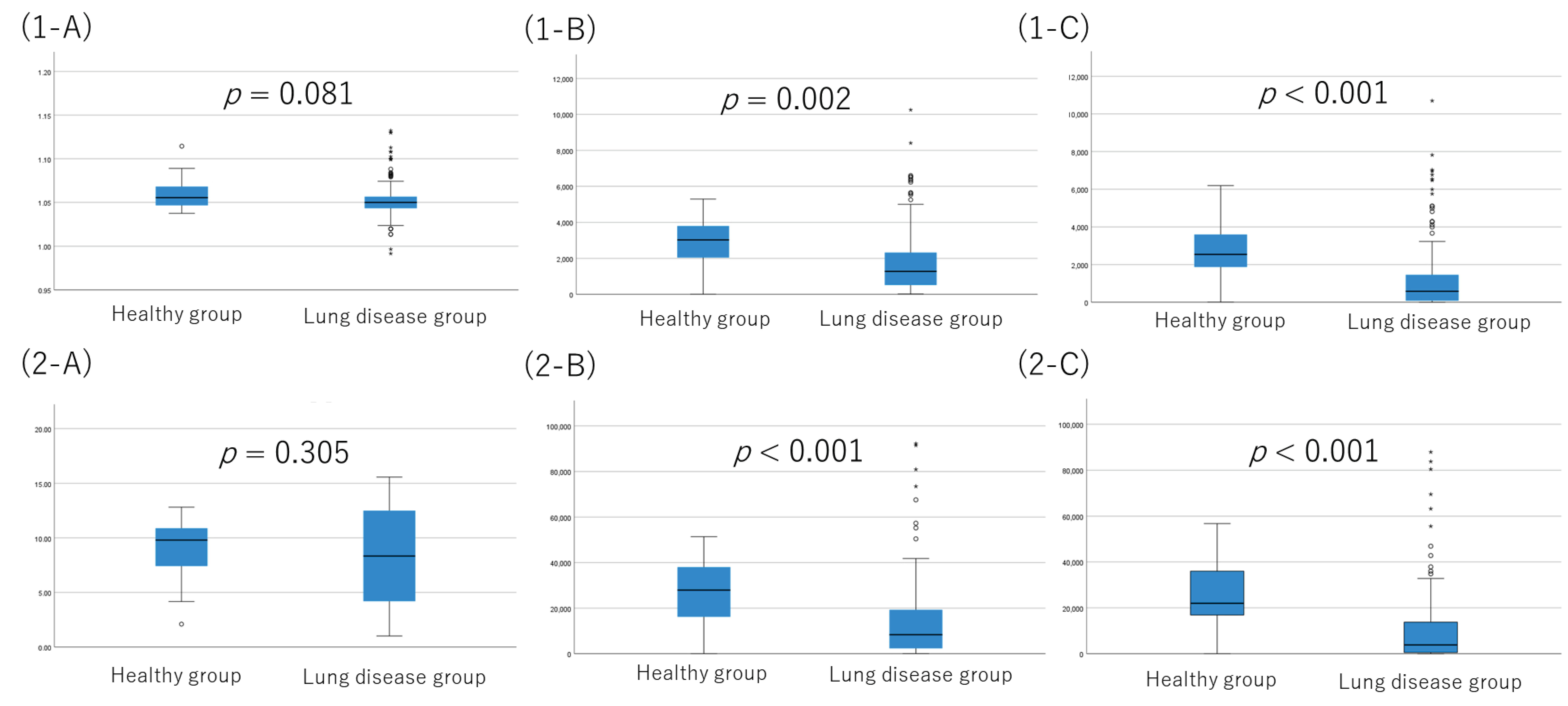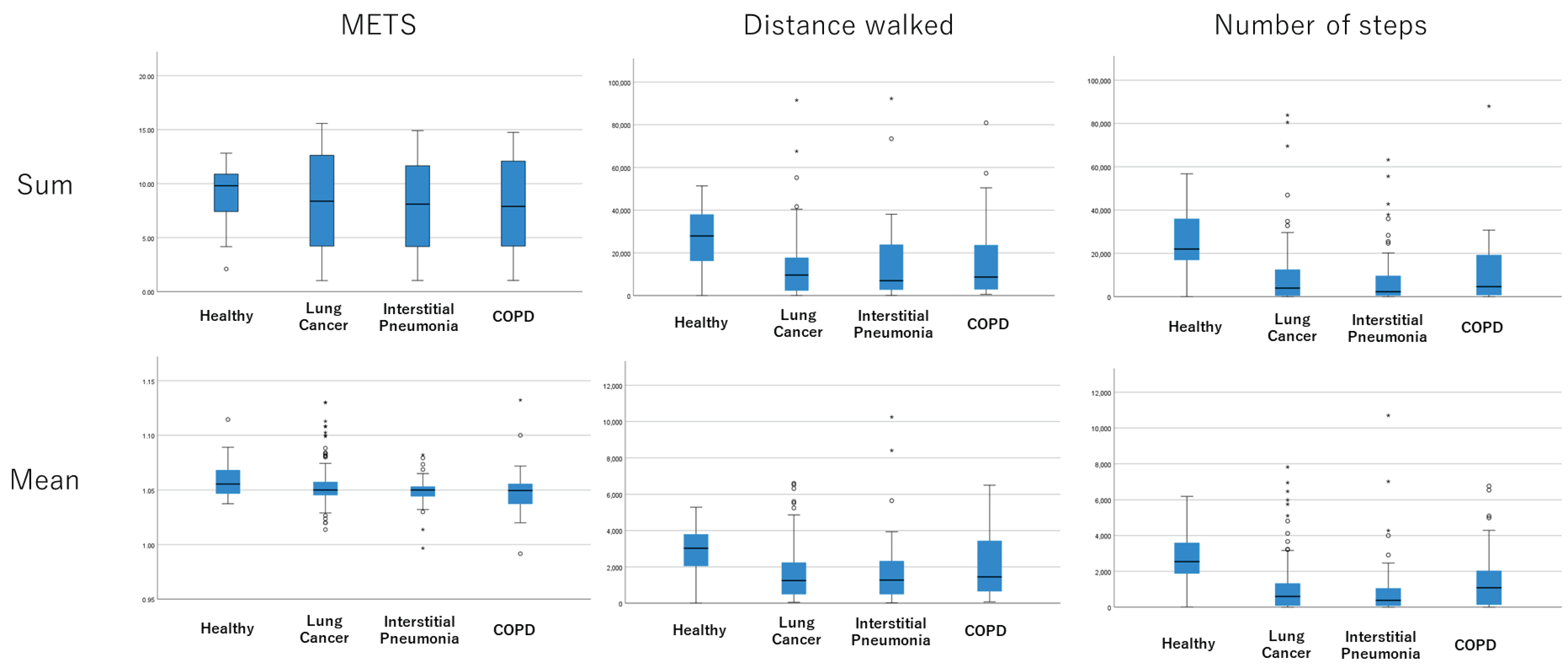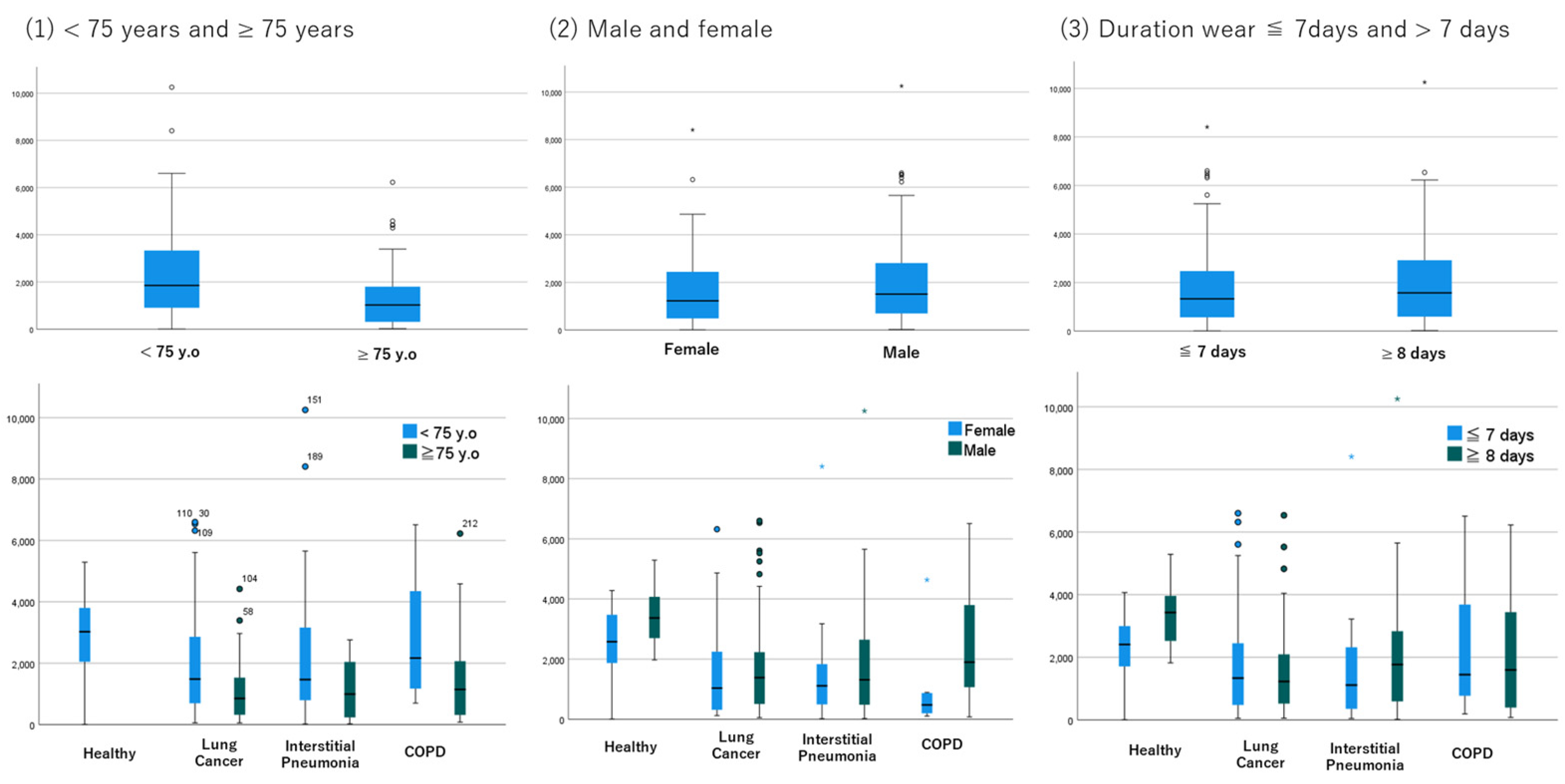Physical Activity Estimated by the Wearable Device in Lung Disease Patients: Exploratory Analyses of Prospective Observational Study
Abstract
1. Introduction
2. Materials and Methods
2.1. Patients
2.2. Measurement of Physical Activity
2.3. Outcome
2.4. Statistics and Ethics
3. Results
3.1. Characteristics
3.2. Healthy vs. Pulmonary Disease
3.3. Across the Subtype of Pulmonary Disease
3.4. Subgroups by Age, Gender, and the Wearing Period
4. Discussion
5. Conclusions
Author Contributions
Funding
Institutional Review Board Statement
Informed Consent Statement
Data Availability Statement
Acknowledgments
Conflicts of Interest
References
- Liao, S.Y.; Benzo, R.; Ries, A.L.; Soler, X. Physical Activity Monitoring in Patients with Chronic Obstructive Pulmonary Disease. Chronic Obstr. Pulm. Dis. 2014, 1, 155–165. [Google Scholar] [CrossRef] [PubMed]
- Esteban, C.; Quintana, J.M.; Aburto, M.; Moraza, J.; Egurrola, M.; Pérez-Izquierdo, J.; Aizpiri, S.; Aguirre, U.; Capelastegui, A. Impact of changes in physical activity on health-related quality of life among patients with COPD. Eur. Respir. J. 2010, 36, 292–300. [Google Scholar] [CrossRef] [PubMed]
- Garcia-Aymerich, J.; Lange, P.; Benet, M.; Schnohr, P.; Antó, J.M. Regular physical activity reduces hospital admission and mortality in chronic obstructive pulmonary disease: A population based cohort study. Thorax 2006, 61, 772–778. [Google Scholar] [CrossRef] [PubMed]
- Dhillon, H.M.; Bell, M.L.; van der Ploeg, H.P.; Turner, J.D.; Kabourakis, M.; Spencer, L.; Lewis, C.; Hui, R.; Blinman, P.; Clarke, S.J.; et al. Impact of physical activity on fatigue and quality of life in people with advanced lung cancer: A randomized controlled trial. Ann. Oncol. 2017, 28, 1889–1897. [Google Scholar] [CrossRef] [PubMed]
- Nakayama, M.; Bando, M.; Araki, K.; Sekine, T.; Kurosaki, F.; Sawata, T.; Nakazawa, S.; Mato, N.; Yamasawa, H.; Sugiyama, Y. Physical activity in patients with idiopathic pulmonary fibrosis. Respirology 2015, 20, 640–646. [Google Scholar] [CrossRef] [PubMed]
- Pitta, F.; Troosters, T.; Spruit, M.A.; Probst, V.S.; Decramer, M.; Gosselink, R. Characteristics of physical activities in daily life in chronic obstructive pulmonary disease. Am. J. Respir. Crit. Care Med. 2005, 171, 972–977. [Google Scholar] [CrossRef]
- Wallaert, B.; Monge, E.; Le Rouzic, O.; Wémeau-Stervinou, L.; Salleron, J.; Grosbois, J.M. Physical activity in daily life of patients with fibrotic idiopathic interstitial pneumonia. Chest 2013, 144, 1652–1658. [Google Scholar] [CrossRef]
- Breuls, S.; Pereira de Araujo, C.; Blondeel, A.; Yserbyt, J.; Janssens, W.; Wuyts, W.; Troosters, T.; Demeyer, H. Physical activity pattern of patients with interstitial lung disease compared to patients with COPD: A propensity-matched study. PLoS ONE 2022, 17, e0277973. [Google Scholar] [CrossRef]
- Ishikawa-Takata, K.; Nakae, S.; Sasaki, S.; Katsukawa, F.; Tanaka, S. Age-Related Decline in Physical Activity Level in the Healthy Older Japanese Population. J. Nutr. Sci. Vitaminol. 2021, 67, 330–338. [Google Scholar] [CrossRef]
- da Silva, I.C.; van Hees, V.T.; Ramires, V.V.; Knuth, A.G.; Bielemann, R.M.; Ekelund, U.; Brage, S.; Hallal, P.C. Physical activity levels in three Brazilian birth cohorts as assessed with raw triaxial wrist accelerometry. Int. J. Epidemiol. 2014, 43, 1959–1968. [Google Scholar] [CrossRef]
- Mielke, G.I.; Burton, N.W.; Brown, W.J. Accelerometer-measured physical activity in mid-age Australian adults. BMC Public Health 2022, 22, 1952. [Google Scholar] [CrossRef]





| All | Healthy Control | Pulmonary Disease | Lung Cancer | Interstitial Pneumonia | COPD | |
|---|---|---|---|---|---|---|
| N | 238 | 22 | 216 | 119 | 51 | 46 |
| Median age [range] ≥75 years old | 73 (24–88) 99 (41.6%) | 36 (24–58) 0 (0%) | 74 (32–88) 99 (45.8%) | 72 (32–88) 47 (39.5%) | 74 (54–85) 24 (47.1%) | 75 (43–83) 28 (60.9%) |
| Sex M/F | 152/86 | 9/13 | 143/73 | 71/48 | 34/17 | 38/8 |
| Wearing days, median ≤7 days | 8 117 (49.2%) | 9 7 (31.8%) | 7 110 (50.9%) | 7 60 (50.4%) | 8 25 (49.0%) | 7 25 (54.3%) |
| Failure to estimate PA | 13 (5.5%) | 0 (0%) | 13 (%) | 8 (6.7%) | 0 (0%) | 5 (10.9%) |
| Parameter of Physical Activity to Subtype of Pulmonary Disease for Null Hypothesis | Kruskal–Wallis Test | Multiple Comparison Test | |||||
|---|---|---|---|---|---|---|---|
| LK vs. IP | LK vs. CO | LK vs. HE | IP vs. CO | IP vs. HE | CO vs. HE | ||
| Sum of METS | 0.769 | - | |||||
| Mean of METS | 0.090 | - | |||||
| Sum of distance walked | <0.001 | 0.892 | 0.596 | <0.001 | 0.723 | <0.001 | 0.002 |
| Mean of distance walked | <0.001 | 0.842 | 0.178 | <0.001 | 0.310 | <0.001 | 0.006 |
| Sum of steps walked | <0.001 | 0.609 | 0.437 | <0.001 | 0.276 | <0.001 | <0.001 |
| Mean of steps walked | <0.001 | 0.409 | 0.219 | <0.001 | 0.083 | <0.001 | <0.001 |
Disclaimer/Publisher’s Note: The statements, opinions and data contained in all publications are solely those of the individual author(s) and contributor(s) and not of MDPI and/or the editor(s). MDPI and/or the editor(s) disclaim responsibility for any injury to people or property resulting from any ideas, methods, instructions or products referred to in the content. |
© 2023 by the authors. Licensee MDPI, Basel, Switzerland. This article is an open access article distributed under the terms and conditions of the Creative Commons Attribution (CC BY) license (https://creativecommons.org/licenses/by/4.0/).
Share and Cite
Ito, K.; Esumi, M.; Esumi, S.; Suzuki, Y.; Sakaguchi, T.; Fujiwara, K.; Nishii, Y.; Yasui, H.; Taguchi, O.; Hataji, O. Physical Activity Estimated by the Wearable Device in Lung Disease Patients: Exploratory Analyses of Prospective Observational Study. J. Clin. Med. 2023, 12, 4424. https://doi.org/10.3390/jcm12134424
Ito K, Esumi M, Esumi S, Suzuki Y, Sakaguchi T, Fujiwara K, Nishii Y, Yasui H, Taguchi O, Hataji O. Physical Activity Estimated by the Wearable Device in Lung Disease Patients: Exploratory Analyses of Prospective Observational Study. Journal of Clinical Medicine. 2023; 12(13):4424. https://doi.org/10.3390/jcm12134424
Chicago/Turabian StyleIto, Kentaro, Maki Esumi, Seiya Esumi, Yuta Suzuki, Tadashi Sakaguchi, Kentaro Fujiwara, Yoichi Nishii, Hiroki Yasui, Osamu Taguchi, and Osamu Hataji. 2023. "Physical Activity Estimated by the Wearable Device in Lung Disease Patients: Exploratory Analyses of Prospective Observational Study" Journal of Clinical Medicine 12, no. 13: 4424. https://doi.org/10.3390/jcm12134424
APA StyleIto, K., Esumi, M., Esumi, S., Suzuki, Y., Sakaguchi, T., Fujiwara, K., Nishii, Y., Yasui, H., Taguchi, O., & Hataji, O. (2023). Physical Activity Estimated by the Wearable Device in Lung Disease Patients: Exploratory Analyses of Prospective Observational Study. Journal of Clinical Medicine, 12(13), 4424. https://doi.org/10.3390/jcm12134424






